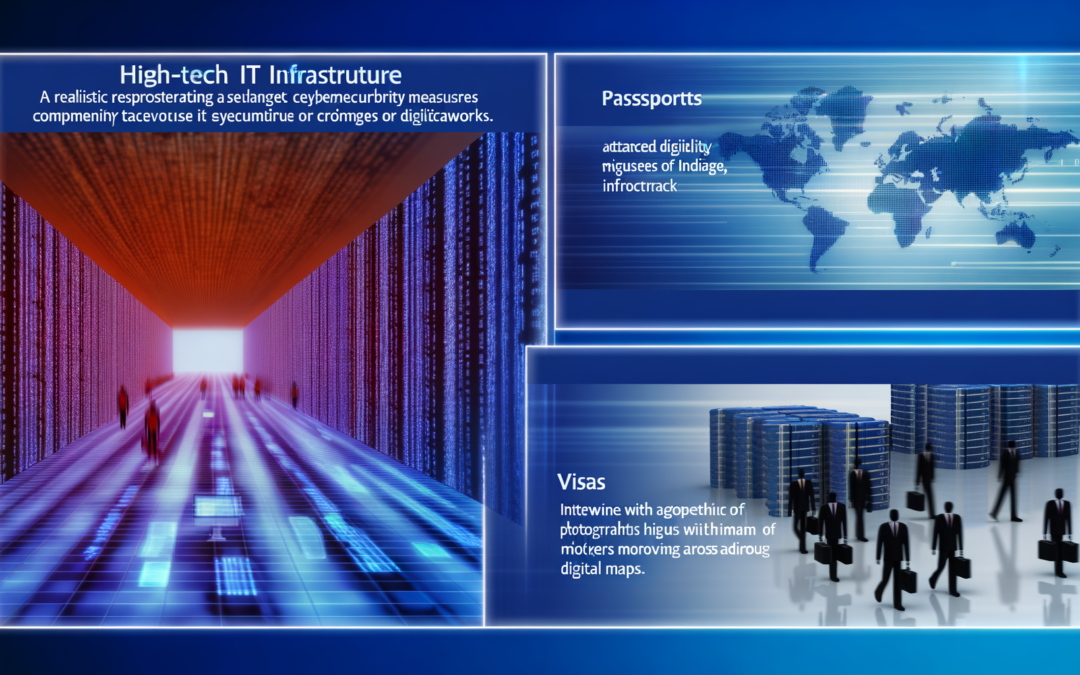This article explores the intersection of cybersecurity and the exclusive eMigrate system in India. Learn how India’s IT infrastructure is fortified against cyber threats and how the eMigrate system offers unique advantages for Indian expatriates.
India’s Cybersecurity Landscape
India’s Cybersecurity Landscape:
India’s cybersecurity landscape is rapidly evolving as the country embraces digitalization, but it also faces significant challenges in safeguarding its networks, systems, and data. With the increasing number of cyber threats and attacks, the government and private sector have been collaborating intensely to strengthen India’s cyber defenses.
The government has implemented various measures to enhance digital security, including the National Cyber Security Policy, which aims to protect critical information infrastructure, build a resilient cyber ecosystem, and enhance capabilities for addressing cyber threats. Additionally, the establishment of the Indian Cyber Crime Coordination Centre (I4C) and the National Cyber Coordination Centre (NCCC) play a crucial role in monitoring and responding to cyber incidents.
India faces challenges such as sophisticated cyber attacks, data breaches, ransomware attacks, phishing scams, and social engineering attacks. To combat these threats, the government has been focusing on capacity building, raising cyber awareness, promoting cybersecurity best practices, and enhancing collaboration between different stakeholders.
Moreover, the government has been working closely with the private sector to strengthen cybersecurity measures. This collaboration involves sharing threat intelligence, conducting joint cybersecurity exercises, and implementing best practices to protect critical infrastructure and sensitive data. The public-private partnership has been essential in developing a robust cybersecurity framework and responding effectively to cyber incidents.
As India continues to digitize and move towards a digital economy, ensuring cybersecurity becomes paramount to safeguarding national interests and maintaining trust in the digital ecosystem. With the ever-evolving cybersecurity landscape, continuous efforts are required to stay ahead of cyber threats and mitigate risks effectively.
eMigrate:
The eMigrate system in India plays a crucial role in regulating the migration of Indian workers overseas. It is an exclusive online platform that aims to streamline the emigration process, protect the rights of Indian expatriates, and prevent fraudulent practices in the recruitment of Indian workers.
The eMigrate system operates as a centralized portal where Indian workers planning to migrate overseas can register and obtain mandatory clearance from the Protector General of Emigrants (PGoE). This clearance ensures that the recruitment process is transparent, and the welfare of the workers is protected.
One of the exclusive features of the eMigrate system is the Pre-Departure Orientation Training (PDOT) program, which provides essential information about the destination country, the terms of employment, and the rights and responsibilities of the workers. This training helps in preparing Indian workers for the challenges they might face while working abroad.
Overall, the eMigrate system has been instrumental in enhancing the transparency and efficiency of the emigration process in India. By leveraging technology and implementing strict regulations, the system has contributed to safeguarding the interests of Indian expatriates and ensuring a smoother migration experience for them.
The Exclusive eMigrate System
The eMigrate system in India stands as a pioneering platform that revolutionizes the migration process for Indian expatriates. This exclusive system offers a comprehensive framework that ensures the security and efficiency of the migration process, setting it apart from traditional methods.
**Operational Framework:**
– The eMigrate system functions as a centralized platform for managing the emigration process, eliminating the need for paper-based documentation and physical submissions.
– Applicants can create profiles, submit documents, track application status, and receive notifications through the online portal, streamlining the entire process.
– The system is integrated with various government departments and agencies to verify information and conduct background checks, enhancing the security and reliability of the migration process.
**Benefits for Indian Expatriates:**
– The eMigrate system offers numerous benefits for Indian expatriates, including faster processing times, real-time updates on application status, and enhanced security measures.
– By digitizing the migration process, applicants can avoid long queues, tedious paperwork, and potential document misplacements, leading to a more seamless experience.
– The system also provides a level of transparency and accountability that was previously lacking in the emigration process, instilling greater trust among users.
**Impact on Streamlining Migration Process:**
– The eMigrate system has significantly improved the efficiency of the migration process by reducing paperwork, minimizing manual errors, and accelerating application processing times.
– With the integration of advanced technology and security measures, the system ensures the integrity and confidentiality of users’ information, safeguarding against potential data breaches or unauthorized access.
– The centralized nature of the eMigrate system allows for better coordination between government agencies, leading to more effective monitoring and regulation of migration activities.
In conclusion, the eMigrate system in India represents a paradigm shift in the way migration processes are managed, offering a secure, exclusive, and efficient platform for Indian expatriates. By embracing technological innovations and stringent security measures, the system not only enhances the user experience but also sets a new standard for emigration systems worldwide.
Integrating Cybersecurity with eMigrate
With the rapid digitization of processes across various sectors, including migration, cybersecurity has become a crucial aspect to ensure the protection of sensitive data. In the context of eMigrate in India, integrating robust cybersecurity protocols is essential to safeguard the information of users and maintain the integrity of the system.
One of the key elements of cybersecurity in the eMigrate system is encryption. By encrypting data transmitted through the platform, sensitive information such as personal details, passport information, and employment history are protected from unauthorized access. This encryption mechanism ensures that only authorized personnel can decrypt and access the data, enhancing the overall security of the system.
Additionally, multi-factor authentication is another vital component of cybersecurity in the eMigrate system. By requiring users to go through multiple authentication steps—such as entering a password, receiving a code on their mobile device, or using biometric authentication—the system adds an extra layer of security to verify the identity of users. This reduces the risk of unauthorized access and minimizes the chances of data breaches.
Furthermore, regular security audits and penetration testing are conducted to identify any vulnerabilities within the eMigrate system. These assessments help in pinpointing potential weak points in the system that could be exploited by cyber attackers. By addressing these vulnerabilities proactively, the eMigrate system can strengthen its defenses and prevent cyber threats from compromising the security of users’ data.
Incorporating technologies like blockchain can also enhance the cybersecurity of the eMigrate system. Blockchain offers a decentralized and tamper-proof platform for storing transactional data securely. By leveraging blockchain technology, the eMigrate system can ensure the integrity and confidentiality of users’ information, making it resistant to unauthorized modifications or hacks.
Moreover, implementing robust security practices such as regular software updates, intrusion detection systems, and security monitoring tools are essential to fortify the eMigrate system against cyber threats. By staying vigilant and proactive in detecting and mitigating security risks, the system can uphold its commitment to protecting the privacy and confidentiality of users’ data.
In conclusion, integrating cybersecurity measures into the eMigrate system is paramount to guaranteeing the safety and security of sensitive information. By employing encryption, multi-factor authentication, regular security audits, and emerging technologies like blockchain, the eMigrate system can establish a robust defense against cyber threats and maintain the exclusivity and integrity of the migration process in India.
Future Prospects for Secure Migration
In the realm of secure migration, the future holds numerous possibilities for advancements in both cybersecurity and the eMigrate system in India. These developments have the potential to revolutionize the security and efficiency of migration processes, ensuring the protection of sensitive data and enhancing the exclusivity of eMigrate.
**Future Cybersecurity Advancements:**
1. **Advanced Encryption Techniques:** As cyber threats evolve, so must the encryption techniques used to protect data. Future advancements may include the implementation of quantum-resistant encryption methods to safeguard sensitive information from potential security breaches.
2. **Biometric Authentication:** The future of cybersecurity in migration processes may see the widespread adoption of biometric authentication methods. This could involve the use of fingerprint scanning, facial recognition technology, or even iris scans to verify the identity of individuals seeking to migrate.
3. **AI-Powered Security Systems:** Artificial intelligence (AI) has the potential to revolutionize cybersecurity practices by identifying and mitigating potential threats in real-time. AI-powered security systems can analyze patterns of behavior, detect anomalies, and respond to security incidents more efficiently than traditional methods.
**Implications for Secure Migration:**
1. **Enhanced Security Measures:** The integration of advanced cybersecurity technologies into the eMigrate system can significantly enhance the overall security of migration processes. This can help in preventing unauthorized access to sensitive data and ensuring the confidentiality of users’ information.
2. **Streamlined Migration Processes:** By incorporating cutting-edge technologies such as biometric authentication and AI-powered security systems, the eMigrate system can streamline migration processes and reduce the time and effort required for verification and approval. This can lead to greater efficiency in managing migration flows and ensuring the smooth movement of individuals across borders.
3. **Improved User Experience:** The implementation of future cybersecurity advancements in the eMigrate system can enhance the overall user experience for individuals seeking to migrate. By prioritizing security and efficiency, the system can provide a seamless and secure platform for users to access migration services with confidence.
In conclusion, the future prospects for secure migration in India are promising, with advancements in cybersecurity and the eMigrate system set to transform the landscape of migration processes. By embracing cutting-edge technologies and innovative security measures, India can ensure the protection of sensitive data, enhance the exclusivity of the eMigrate system, and provide a secure and efficient platform for individuals seeking to migrate.
Conclusions
In conclusion, India’s robust cybersecurity measures and the exclusive eMigrate system highlight the nation’s commitment to protecting digital assets and facilitating seamless migration processes. The integration of advanced technology ensures India remains a leader in both security and expatriate management.

